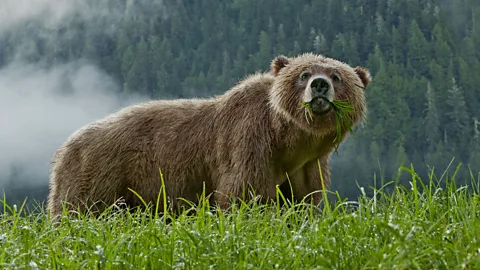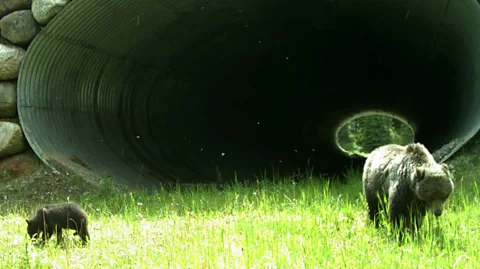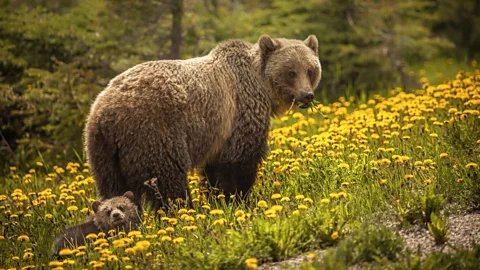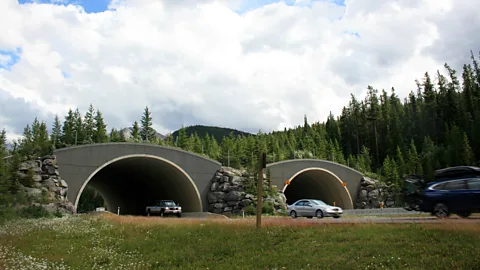Tunnels, trails, bridges built especially for bears
BBC carries an article about bears, mountains are considered ideal for them as their diverse landscape provides a range of foods for them, as well as shelter and safety away from humans, Caliber.Az reprints the article.
To truly thrive, bears and other wild animals need to roam widely between habitats. Wildlife tunnels, trails and bridges can help – but are they enough?
In the north-west of the US, a rocky green and grey landscape juts and curves its way north to Canada, and south to Mexico. These are the Rocky Mountains, home to roving wolverine, majestic elk – and several hundred grizzly bears, whose population has been recovering thanks to efforts to reconnect their habitat so they can roam more freely.

Though huge – the tallest mountain is over 4,000m (13,123ft) high, and the range stretches a full 4,800km (2,983 miles) – the Rocky Mountains are not the wild expanse of land they once were. Towns and cities have formed in valleys, and roads have cut across the land to connect them. For wildlife, and especially the bears, this creates a problem.
Bears need space to thrive – lots of it. A typical grizzly bear needs 80 to 965 sq km (50 to 600 sq miles) to find appropriate food and meet new mates. They look for deer by the river, catch fish in mountain creeks, and forage grasses, bulbs and berries in forests and on mountain sides. A 2014 study followed a grizzly bear called Ethyl as she wound her way 2,800 miles (4,506 km) through Montana, into Idaho, and up to the border with British Columbia. But safe, connected stretches of wilderness have become hard to find, says Mark Hebblewhite, professor of Ungulate Habitat Ecology at the University of Montana, who has spent his career studying the animal inhabitants of the Rocky Mountains' peaks and valleys.
"I'm here walking above the city of Missoula, a little city of 50,000 people," he says, speaking on his mobile while out on a hike. "And I see a new development going in that's going to carve up another 600 acres (2.43 sq km) with 200 homes". These homes are needed – but they are an example of how the world's biggest, most expansive ecosystems become fragmented as humans move in.

Helping animals roam and connect
One solution is to help bears and other wildlife cross from one protected area to the next. This can be done with something as simple as a highway underpass or overpass, researchers say – a kind of bear tunnel, or bear bridge. Another solution is to prevent an area from being turned into roads and housing, so it can connect two protected areas even if it does not have protected status itself. Known as wildlife corridors, or ecological corridors, these connecting strips and areas are gaining more scientific attention. In recent years, they have begun to reconnect habitat for tigers in Nepal, bees in Britain and deer in the Netherlands.
Ecological corridors "are super important, because what research over time has shown is that most of our protected areas are too small to maintain all of the species and ecological processes within them," says Jodi Hilty, who has spent her career researching and creating such corridors. She is president and chief scientist at Yellowstone to Yukon (Y2Y) – an initiative that aims to build connections between important habitats along the spine of the Rocky Mountains.
The Yellowstone to Yukon region spans 1.3 million sq km (501,933 sq miles), stretching from Wyoming's Yellowstone National Park in the south to Canada's Yukon Territory in the north. Since the Yellowstone to Yukon initiative launched in 1993, its team of scientists and other experts have turned this vast tract of land from a disjointed patchwork of protected areas, into a more coherent, connected space for animals to roam. The area is now the most intact mountain region in the world, with 95 per cent of its land classified as "wild" – though only about 16 per cent of the overall region is protected land.
A bear paradise
Mountains are considered ideal for bears as their diverse landscape provides a range of foods for them, as well as shelter and safety away from humans. Roaming widely is the only way they can meet their broad dietary needs, Hebblewhite explains. "Grizzly bears are omnivores, so that means they eat meat and plants. That gives them great flexibility, because they can shift their diet over the season as different foods are available. But that also means they have to shift their use of space to take advantage of those new foods."
In 1985, the number of grizzly bears in the Yellowstone region was as low as 200. By 2010, this number had risen to 600. Restrictions on hunting are likely to have contributed to this recovery, but Hilty says connecting the bears' scattered habitats has been another important factor.
Mountains also help many other kinds of wildlife, providing a home for vulnerable species, and providing an important sanctuary in times of climate change as animals can move up the mountain to find cooler habitats. A quarter of all biological diversity on land lives in mountain regions, including many species that live exclusively at high altitude. The Rocky Mountains are home to threatened lynx, swans and bats, and to some of the larger mammals that have been wiped out in many areas around the world such as wolves and mountain caribou.
On the other hand, private lands, typically located in valley bottoms, are dangerous for bears. Rubbish bins and chicken coops attract bears and bring them into conflict with humans – which is "usually a very unhappy story for the bear," Hilty says, as the bear may then be shot. "We do a lot of coexistence work to make sure that whether it's a rural ranching community or an urban community, that animals like grizzly bears can pass through without getting into trouble."

Research suggests that grizzly bears are both feared and revered by humans in areas where their population is recovering, and that trust or mistrust in the agency managing the population also influenced how they felt about the number of bears in the area. Measures to prevent bears from getting too close to humans can involve electric fences, bear proof dumpsters, and educating locals to only put bird feed out when bears are sleeping. Preventing encounters helps both humans and bears stay safe, research suggests: approximately eight grizzly bears a year are killed by cars in Alberta, Canada, (35 per cent of all known deaths), while 12 are shot dead (52 per cent of deaths).
Allowing bears to cross from one area to another without venturing into human settlements can help reduce such clashes. One especially powerful intervention: helping bears cross the road.
Crossings for bears, moose – and salamanders
Scientists set up remote cameras to study where and when animals try to cross the highway. "It's really about asking, where does the grizzly bear cross the road?" Hilty says. The findings show the Yellowstone to Yukon team where to focus their efforts on building a bridge or tunnel, usually with a fence along the nearby section of highway.
Research has shown that such crossings are effective as they reduce collisions between cars and large mammals by 80–97 per cent. The team has so far constructed 127 wildlife crossings that support various species, some big enough to support bears and moose, others specially designed to offer toads or salamanders a tunnel to safety. Hilty says "we're not close to being done, but it's great that those exist and that there are many more in the process of moving forward".
While guns and cars are perhaps the most obvious danger to bears, a quieter and equally existential threat is isolation – not meeting others of their species to mate with. Barriers such as highways prevent different bears from meeting and mingling. Without new mates, the gene pool shrinks, putting the overall health and growth of their population at risk.

On a more fundamental level, we humans need to acknowledge that land is here to be shared, says Whisper Camel-Means. She is a member of the Qlispe tribe and a wildlife biologist working for the Confederated Salish and Kootenai Tribal Natural Resources Department, which partners with the Y2Y project.
"Tolerance is the big picture here," she says. "There are tribal connections to grizzly bears that are very strong, they are very revered. But with new people [moving into the area], it's hard to create that tolerance, because they have ideas of what they want to do with their land."
Among the biggest challenges as new people arrive in the area is to help them understand that if they spot a wild bear, the best response is to go inside and let the bear continue on its journey, she says – not try to have it trapped or killed.

For Camel-Means, this is not only about respecting the bear, it is also about respecting communities like her own, which have been living with bears and other wildlife here for a very long time.
"Protection of wildlife [is] the conduit for the protection of our culture," Camel-Means says. There has been growing awareness that too often, conservation projects around the world undermine the communities of people living in areas of wildlife habitat. Indigenous tribes were pushed off the land when Yellowstone National Park was established in 1872. As Hilty says, "conservation has a dark side to its history". Thankfully, for the Salish and Kootenai communities, a historical treaty has protected their land rights and prevented such evictions.
Currently, 25 per cent of the Y2Y project is managed or co-managed by Indigenous people – "and we hope that amount will increase significantly", Hilty says.
Hilty's hope is that efforts aimed at helping the bears will also protect other, less well-known species.
Flowing phlox and jumping slugs
The Rocky Mountains are home to many rare plants and animals: jumping slugs, for example, and a white flowering phlox plant grows that can't be found anywhere else, and as many as 400 vertebrate species.
Hilty explains, "it's assumed that if you take care of the needs of an umbrella species, like a grizzly bear, then the needs of most other species will also be met". Climate change is making the need for corridors especially urgent, Hilty says, as corridors "allow animals to move further north as the climate changes, to try to find their ideal climate. They can also move up in elevation, and they can move to different slopes".
Research is now looking at which areas the animals in the region will need to access in future, so the team can map pathways to get there. "We've worked with not only the species biologists, but also the climate change folks to make sure that we're identifying corridors that are going to be robust now, and 100 years from now," Hilty says.
Hebblewhite argues that corridors are in fact much more than crossings and pathways, and should be valued as habitat in their own right. "I actually don't like the term corridor," he says. "Do we have lunch in the corridor? Do we sleep in a corridor? No. And so the idea that a corridor is only used by species to travel quickly from point A to point B, is just not true for most species of wildlife."
Hilty says understanding ecological connectivity can help us grasp how the natural world works, and how we fit into it. "There is really an understanding that we are part of nature. And as we lose it, we could get ourselves into big trouble. And this is one of the missing tools that I think can help us get out of our current dilemma."








